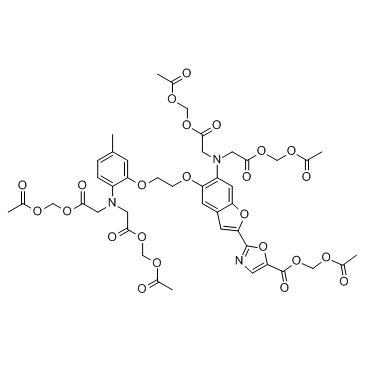Fura-2, AM

Fura-2, AM structure
|
Common Name | Fura-2, AM | ||
|---|---|---|---|---|
| CAS Number | 108964-32-5 | Molecular Weight | 1001.850 | |
| Density | 1.4±0.1 g/cm3 | Boiling Point | 975.9±75.0 °C at 760 mmHg | |
| Molecular Formula | C44H47N3O24 | Melting Point | N/A | |
| MSDS | Chinese USA | Flash Point | 544.0±37.1 °C | |
|
Neuroprotection against degeneration of sk-N-mc cells using neuron growth factor-encapsulated liposomes with surface cereport and transferrin.
J. Pharm. Sci. 103(8) , 2484-97, (2014) Liposomes with Cereport (RMP-7) and transferrin (Tf) (RMP-7/Tf/liposomes) were employed to target the blood-brain barrier (BBB) and to inhibit the degeneration of neurons insulted with fibrillar β-amyloid peptide 1-42 (Aβ1-42). Neuron growth factor (NGF)-enca... |
|
|
Susceptibility of murine induced pluripotent stem cell-derived cardiomyocytes to hypoxia and nutrient deprivation.
Stem Cell Res. Ther. 6 , 83, (2015) Induced pluripotent stem cell-derived cardiomyocytes (iPS-CMs) may be suitable for myocardial repair. While their functional and structural properties have been extensively investigated, their response to ischemia-like conditions has not yet been clearly defi... |
|
|
Hypobaric Preconditioning Modifies Group I mGluRs Signaling in Brain Cortex.
Neurochem. Res. 40 , 2200-10, (2015) The study assessed involvement of Ca(2+) signaling mediated by the metabotropic glutamate receptors mGluR1/5 in brain tolerance induced by hypoxic preconditioning. Acute slices of rat piriform cortex were tested 1 day after exposure of adult rats to mild hypo... |
|
|
CaV3.2 T-type Ca²⁺ channels in H₂S-mediated hypoxic response of the carotid body.
Am. J. Physiol. Cell Physiol. 308(2) , C146-54, (2015) Arterial blood O2 levels are detected by specialized sensory organs called carotid bodies. Voltage-gated Ca(2+) channels (VGCCs) are important for carotid body O2 sensing. Given that T-type VGCCs contribute to nociceptive sensation, we hypothesized that they ... |
|
|
Purinergic Receptors in Spinal Cord-Derived Ependymal Stem/Progenitor Cells and Their Potential Role in Cell-Based Therapy for Spinal Cord Injury.
Cell. Transplant. 24 , 1493-509, (2015) Spinal cord injury (SCI) is a major cause of paralysis with no current therapies. Following SCI, large amounts of ATP and other nucleotides are released by the traumatized tissue leading to the activation of purinergic receptors that, in coordination with gro... |
|
|
Electrophysiological changes in laterodorsal tegmental neurons associated with prenatal nicotine exposure: implications for heightened susceptibility to addict to drugs of abuse.
J Dev Orig Health Dis 6 , 182-200, (2015) Prenatal nicotine exposure (PNE) is a risk factor for developing an addiction to nicotine at a later stage in life. Understanding the neurobiological changes in reward related circuitry induced by exposure to nicotine prenatally is vital if we are to combat t... |
|
|
Heme oxygenase-1 regulates cell proliferation via carbon monoxide-mediated inhibition of T-type Ca2+ channels.
Pflugers Arch. 467(2) , 415-27, (2015) Induction of the antioxidant enzyme heme oxygenase-1 (HO-1) affords cellular protection and suppresses proliferation of vascular smooth muscle cells (VSMCs) associated with a variety of pathological cardiovascular conditions including myocardial infarction an... |
|
|
Onion (Allium cepa L.) peel extract has anti-platelet effects in rat platelets.
Springerplus 4 , 17, (2015) The effects of onion peel extract (OPE) in collagen (5 μg/mL)-stimulated washed rat platelet aggregation were investigated. OPE inhibited platelet aggregation via inhibition of aggregation-inducing molecules, intracellular Ca(2+) and thromboxane A2 (TXA2) by ... |
|
|
The secretory deficit in islets from db/db mice is mainly due to a loss of responding beta cells.
Diabetologia 57(7) , 1400-9, (2014) We used the db/db mouse to determine the nature of the secretory defect in intact islets.Glucose tolerance was compared in db/db and wild-type (WT) mice. Isolated islets were used: to measure insulin secretion and calcium in a two-photon assay of single-insul... |
|
|
Antiarrhythmic Effects of Dantrolene in Patients with Catecholaminergic Polymorphic Ventricular Tachycardia and Replication of the Responses Using iPSC Models.
PLoS ONE 10 , e0125366, (2015) Catecholaminergic polymorphic ventricular tachycardia (CPVT) is a highly malignant inherited arrhythmogenic disorder. Type 1 CPVT (CPVT1) is caused by cardiac ryanodine receptor (RyR2) gene mutations resulting in abnormal calcium release from sarcoplasmic ret... |